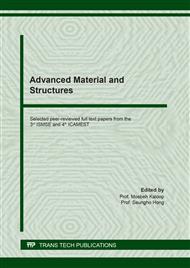[1]
Emetere, M.E., (2020). Photovoltaic Solar Spectral Filtering Using Bio-Filters, Academic Journal of Interdisciplinary Studies, 9:148.
DOI: 10.36941/ajis-2020-0013
Google Scholar
[2]
Ramin M., Alimon A.R., Sijam K. and Abdullah N., (2008). Filter paper degradation by bacteria isolated from local termite gut. Res. J. Microbiol., 3: 565-568.
DOI: 10.3923/jm.2008.565.568
Google Scholar
[3]
Ottenhall A., Henschen J., Illergård, M. Ek, (2018),Cellulose-based water purification using paper filters modified with polyelectrolyte multilayers to remove bacteria from water through electrostatic interactions, Environmental Science Water Research & Technology, 4 (12): 2070-2079.
DOI: 10.1039/c8ew00514a
Google Scholar
[4]
Kasper D, Amaral JHF, Forsberg BR (2018) The effect of filter type and porosity on total suspended sediment determinations. Anal Methods 10(46):5532–5539.
DOI: 10.1039/c8ay02134a
Google Scholar
[5]
Evangelista S., Viccione G., Siani O., (2019),A new cost effective, long life and low resistance filter cartridge for water treatment, J. Water Process Eng., 27:1-14.
DOI: 10.1016/j.jwpe.2018.11.004
Google Scholar
[6]
Hwang S.W., Song J.K., Huang X., Cheng H., Kang S.K., Kim B.H., Kim J.H., Yu S., Huang Y., Rogers J.A. (2014), High-performance biodegradable/transient electronics on biodegradable polymers. Adv. Mater., 26: 3905–3911.
DOI: 10.1002/adma.201306050
Google Scholar
[7]
Bettinger, C.J., Bao, Z. Organic thin-film transistors fabricated on resorbable biomaterial substrates. Adv. Mater. 2010, 22, 651–655.
DOI: 10.1002/adma.200902322
Google Scholar
[8]
Adnan Shihab, Kwang-Man Lee, Mohammad Tayeb Ghasr, Matthew J. O'Keefe, Delbert E. Day, Chang-Soo Kim, (2016), Water-Soluble Glass Substrate as a Platform for Biodegradable Solid-State Devices, IEEE Journal of the Electron Devices Society, 4: 490-494.
DOI: 10.1109/jeds.2016.2606340
Google Scholar
[9]
Adnan, Md Shihab, Biodegradable electronic and optical devices toward temporary implants, (2016). Masters Theses. https://scholarsmine.mst.edu/masters_theses/7864.
Google Scholar
[10]
Yu X., Shou W., Mahajan B.K., Huang X., Pan H., (2018), Materials, processes, and facile manufacturing for bioresorbable electronics: A review. Adv. Mater. 30: 1707624.
DOI: 10.1002/adma.201707624
Google Scholar
[11]
Emetere Moses E., Adeyemo Nehemiah, (2020). Spectral Filtering of Photovoltaic Cells using Novel Bio-Filter: Silver Coated Hibiscus Extract using Water Solution, International Journal of Recent Technology and Engineering, 8:330.
DOI: 10.35940/ijrte.c4618.018520
Google Scholar
[12]
Emetere Moses E., Adeyemo Nehemiah, (2019). Spectral Filtering of Photovoltaic Cells using Novel Bio-Filter: Silver Coated Hibiscus Extract using Butanol Solution, International Journal of Engineering and Advanced Technology, 9:724-727.
DOI: 10.35940/ijeat.f9065.129219
Google Scholar
[13]
Tran T.H., and Nguyen T., (2014), Copper oxide nanomaterials prepared by solution methods, some properties and potential applications: a brief review, Int. Sch. Res. Not. 856592:1-14.
DOI: 10.1155/2014/856592
Google Scholar
[14]
Ishikawa Tsutomu, Masataka Masuda, Yasunori Hayashi (1999), Characterization on the Electrical Properties of Copper Nitride Thin Films and the Effects of Hydrogen Implantation, The Japan Institute of Metals and Materials, 63(5): 621-624.
DOI: 10.2320/jinstmet1952.63.5_621
Google Scholar
[15]
Liu X., Shi M., Luo Y., Zhou L., Loh Z.R., Oon Z.J., Lian X., Wan X., Chong F.B.L., Tong Y., (2020), Degradable and Dissolvable Thin-Film Materials for the Applications of New-Generation Environmental-Friendly Electronic Devices. Appl. Sci., 10: 1320.
DOI: 10.3390/app10041320
Google Scholar


